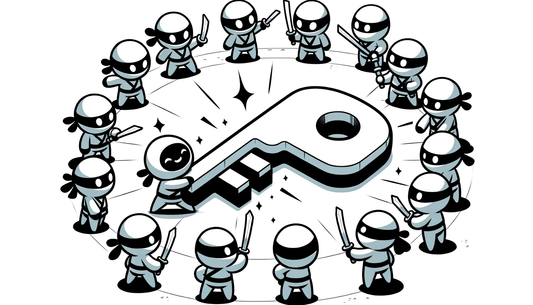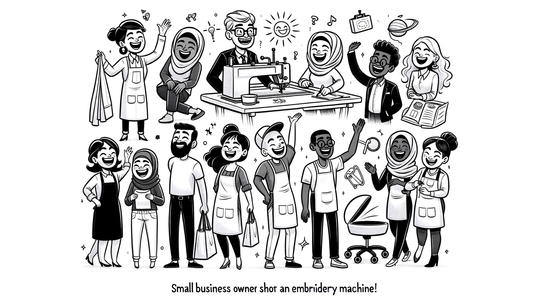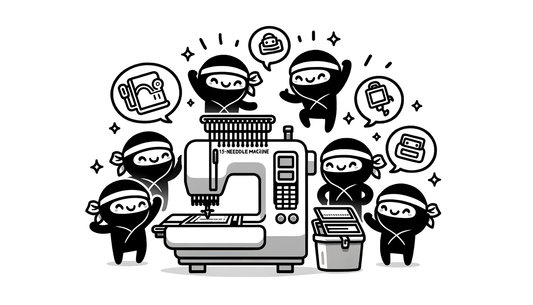
5 Secrets Commercial Embroidery Machine Dealers Won't Tell You
Share
5 Secrets Commercial Embroidery Machine Dealers Won't Tell You
Investing in a commercial embroidery machine is a significant step for any business, hobbyist, or creative entrepreneur. It's crucial to make informed decisions, but the information available can be overwhelming. This guide reveals five essential factors that are often overlooked during the buying process, giving you the knowledge to get the best value and performance from your investment. Understanding these factors will ensure you choose the right machine for your unique needs and budget.
1. The Power of Buying Direct: Cut Out the Middleman
Did you know you can often bypass traditional distributors and purchase directly from the manufacturer? This can unlock significant savings, potentially up to 66%, compared to buying through resellers. Cutting out the middleman not only reduces markups but also often grants you access to better support and the latest machine features sooner. Direct manufacturer relationships often provide a more transparent buying experience, ensuring you understand exactly what you’re paying for. Companies like Embro Ninjas, backed by Yonthin (a publicly listed parent company with over 30 years of manufacturing experience), offer this direct-from-factory advantage, passing the savings directly to you and offering unmatched support.
2. Production Volume Dictates Machine Choice
Your projected production volume is a critical determinant in selecting the right machine. For personalized, niche, or small-volume orders, a single-head machine is generally sufficient. However, for high-production environments, multi-head machines offer greater efficiency, allowing you to embroider multiple items simultaneously. For example, Embro Ninjas' NinjaStarter is an ideal single-head machine designed for versatility and smaller operations, and there are single head machines suitable for personalized, niche, or small-volume orders.
Machines vary significantly in size and capabilities. Compact models (e.g., with 10 to 12 needles, under 3’ x 3’) are suitable for smaller workshops, while industrial multi-head units can handle very large work areas (up to 2,500 mm x 800 mm). Careful assessment of your daily or weekly production requirements is the first step in choosing the right embroidery machine.
3. Unlock Efficiency and Quality with Advanced Features
Advanced features can dramatically impact your workflow efficiency and the quality of your finished products. Features like automatic threading and trimming save significant labor time and reduce the risk of errors. Thread break and bobbin sensors automatically halt the machine, preventing costly faulty designs. Laser guides ensure precise garment placement, while Wi-Fi connectivity enables remote design transfer. Magnetic hoops provide even tension, reduce hoop burn, and facilitate quick fabric changes, boosting productivity. The Embro Ninjas NinjaStarter includes many of these time-saving automation features, like auto-trimming and color change, to make your work easier and more efficient.
4. Financing Options: Making Your Dream Machine Accessible
Don't let upfront costs deter you. Flexible financing options are available to make commercial embroidery machines accessible to a wider range of buyers. Many lenders offer 100% financing that can include shipping, training, and accessories. Qualified buyers may even be eligible for $0 down and 0% interest. Terms typically range from 12 to 60 months, with deferred and seasonal payment options available. Application-only programs up to $75,000 exist, catering to both established and start-up businesses, even those with challenged credit. Ownership is usually transferred at the end of the financing period, making this a finance-to-own arrangement.
5. Beyond the Price Tag: The True Cost of Ownership
The initial price of the machine is only one part of the overall investment. Essential accessories, such as stabilizers, magnetic hoops, extra thread, and digitizing or editing software, are often not included in the base price and must be budgeted for separately. Additionally, some machines, especially entry-level models, may have design or stitch count limitations. For example, some machines may have a limited maximum design area or maximum stitch count per design.
Newer, high-end machines accommodate larger stitch counts (up to 700,000 per design) and embroidery areas (up to 50 x 35 cm or more) and can run at speeds up to 1,200 stitches per minute. The Embro Ninjas NinjaStarter, known for its exceptional value, is designed to handle complex designs and high stitch counts without breaking the bank. It is a feature-rich machine for only $3,999 - $4,999
Making the Right Choice: A Step-by-Step Approach
Here’s a practical guide to evaluating and buying a commercial embroidery machine:
- Assess your projected production volume (daily/weekly units).
- Match production needs to machine type (single-head for small/niche, multi-head for bulk).
- Identify necessary features (automatic threading/trimming, Wi-Fi, laser guide, magnetic hoops).
- Determine required embroidery area and maximum stitch count based on your target designs.
- Research direct manufacturer purchasing options to maximize cost savings.
- Plan for additional required materials (stabilizer, thread, hoops, software).
- Review financing or lease options if outright purchase is not feasible.
- Compare warranty terms and after-sales support; some machines offer up to 7-year limited warranties.
Final Recommendations for Success
Always clarify with the manufacturer or dealer which accessories and consumables come with the machine and what must be purchased separately. Ensure the machine supports the file formats and hoop sizes needed for your intended work. Consider machines with built-in networking if fleet or multi-operator use is likely. Use magnetic hoops for better tension and productivity when working with garments, especially for commercial-scale orders. Double-check maximum embroidery area and design limitations before purchase to ensure future scalability.
Avoiding Common Pitfalls
Here's how to avoid some common problems when buying a commercial embroidery machine:
- Buying from a traditional reseller: You might pay up to 3x more due to middleman markups. The solution is to source machines directly from the manufacturer to save up to 66% on costs, just as Embro Ninjas customers can.
- Inadequate accessories provided at purchase: You won't be able to use the machine for intended projects immediately. Make sure to pre-plan and purchase necessary stabilizers, hoops, thread, and digitizing software before first use.
- Machine not suited for target production scale or embroidery size: This can lead to workflow inefficiencies, inability to fulfill large orders, or restricted design size. Match machine type, speed, and embroidery area to your projected business needs.
By understanding these essential factors, you can confidently navigate the commercial embroidery machine market and make an informed decision that aligns with your business goals and budget.
Question: What is the most important factor to consider when buying a commercial embroidery machine?
Answer: Production volume is often the most important factor, as it dictates whether you need a single-head or multi-head machine.
Your estimated daily or weekly output directly influences the machine type required. Single-head machines are best suited for smaller, custom jobs, while multi-head machines significantly increase efficiency for larger production runs. Carefully assessing your current and projected order volume will help you avoid purchasing a machine that's either underpowered or unnecessarily large for your business needs. It's more cost-effective to start with a machine that meets your immediate needs and scale up later if necessary.
Question: Are financing options available for commercial embroidery machines?
Answer: Yes, various financing options, including loans and leases, are commonly available for commercial embroidery machines.
Financing can make acquiring a machine more accessible by spreading the cost over time. Options often include 100% financing that covers the machine, shipping, training, and accessories. Depending on your creditworthiness, you might find programs with low or even zero down payments and competitive interest rates. Some financing plans offer flexible terms, such as deferred or seasonal payments, to align with your business's cash flow. Explore different financing options to find one that fits your budget and long-term business goals.
Question: What accessories are essential for getting started with a commercial embroidery machine?
Answer: Essential accessories include stabilizers, embroidery thread, hoops, and digitizing software.
Stabilizers provide support to the fabric during embroidery, preventing puckering and ensuring clean stitches. High-quality embroidery thread in various colors is crucial for executing diverse designs. Hoops securely hold the fabric taut, and a range of sizes is helpful for different projects. Digitizing software allows you to convert designs into a format readable by the embroidery machine. These accessories are vital for achieving professional results and should be factored into your initial investment.
Summary: Choosing the right commercial embroidery machine involves understanding hidden costs, accessory needs, and production volume. By purchasing directly and leveraging financing options, businesses can access high-quality embroidery solutions that empower creativity and growth without breaking the bank.


